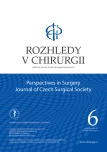Epidural hematoma – benign or potentially malignant disease?
Authors:
N. Svoboda 1; T. Tyll 2; V. Beneš 1; D. Netuka 1
Authors‘ workplace:
Neurochirurgická a neuroonkologická klinika 1. lékařské fakulty Univerzity Karlovy a Ústřední vojenská nemocnice - Vojenská fakultní nemocnice Praha
1; Klinika anesteziologie, resuscitace a intenzivní medicíny 1. lékařské fakulty Univerzity Karlovy a Ústřední vojenská nemocnice - Vojenská fakultní nemocnice Praha
2
Published in:
Rozhl. Chir., 2018, roč. 97, č. 6, s. 267-272.
Category:
Original articles
Overview
Introduction:
Epidural hematoma (EDH) is generally considered to be a condition with a good prognosis. However, postoperative results of numerous studies have shown that mortality and morbidity remain relatively high. The aim of our article is to evaluate surgical outcomes in patients undergoing EDH evacuation over the last five years.
Methods:
Data were analysed retrospectively. Pre-operative GCS was assessed. Location and incidence of associated head injuries were recorded. Two groups were established: 1. “immediate-care-requiring” and “followed-up” patients. Time interval CT – surgery was measured in the first group and the number of CT scans in the second group. Complications were divided into general and surgical. Outcome was evaluated on GOS.
Results:
67 patients underwent the surgery. At admittance, GCS was 13−15 in 55%, 9−12 in 8% and 3–8 in 37% of the patients. EDH was mostly located in the temporal region – in 52%. Associated head injuries occurred in 76%. Mean interval CT – operation lasted 2h 15min in the first group. Two pre-operative CT scans were done in 88% of the patients in the second group. General complications occurred in 34% and surgical in 15%. Mortality rate was 6%. 20% of the patients had a GOS of 1−3 and 80% of them had a GOS of 4–5.
Conclusion:
Our results have shown that morbidity and mortality after EDH evacuation are still relatively high. 14% of the patients remained disabled, and 6% died. The outcome depends mostly on preoperative clinical picture and timing of the surgery.
Key words: epidural hematoma – evacuation − neurological outcome − timing of the surgery
Sources
- Young RJ, Destian S. Imaging of traumatic intracranial hemorrhage. Neuroimaging Clin N Am 2002;12 : 189−204.
- Gupta SK, Tandon SC, Mohanty S, et al. Bilateral traumatic extradural haematomas: report of 12 cases with a review of the literature. Clin Neurol Neurosurg 1992;94 : 127−31.
- Bullock MR, Chesnut R, Ghajar J, et al. Surgical management of acute epidural hematomas. Neurosurgery, 2006;58(3 Suppl):S7−15;discussion Si-iv.
- Rincon S, R. Gupta R, Ptak T. Imaging of head trauma. Handb Clin Neurol 2016;135 : 447−77.
- Grevsten S, Pellettieri L. Surgical decision in the treatment of extradural haematoma. Acta Chir Scand 1982;148 : 97−102.
- Cohen JE, Montero A, Israel ZH. Prognosis and clinical relevance of anisocoria-craniotomy latency for epidural hematoma in comatose patients. J Trauma 1996;41 : 120−2.
- Bricolo AP, Pasut LM. Extradural hematoma: toward zero mortality. A prospective study. Neurosurgery 1984;14 : 8−12.
- Ruff LM, Mendelow AD, Lecky FE. Improving mortality after extradural haematoma in England and Wales. Br J Neurosurg 2013;27 : 19−23.
- Soon WC, Marcus H, Wilson M. Traumatic acute extradural haematoma - Indications for surgery revisited. Br J Neurosurg 2016;30 : 233−4.
- Cook RJ, Dorsch NW, Fearnside MR, et al. Outcome prediction in extradural haematomas. Acta Neurochir (Wien) 1988;95 : 90−4.
- O‘Sullivan MG, Gray WP, Buckley TF. Extradural haematoma in the Irish Republic: an analysis of 82 cases with emphasis on „delay“. Br J Surg 1990;77 : 1391−4.
- Wester K. Decompressive surgery for pure epidural hematomas: does neurosurgical expertise improve the outcome? Neurosurgery 1999;44 : 495−500;discussion 500−2.
- Suchomel P. [Analysis of the causes of failure in the treatment of simple traumatic epidural hematomas.] Czec, Rozhl Chir 1990;69 : 649−54.
- Brabec R. Výsledky chirurgické léčby pacientů s „čistým“ úrazovým epidurálním krvácením. Cesk Slov Neurol N 2015;78 : 323−7.
- Lee EJ, Hung YC, Wang LC, et al. Factors influencing the functional outcome of patients with acute epidural hematomas: analysis of 200 patients undergoing surgery. J Trauma 1998;45 : 946−52.
- Lobato RD, Rivas JJ, Cordobes F, et al. Acute epidural hematoma: an analysis of factors influencing the outcome of patients undergoing surgery in coma. J Neurosurg 1988;68 : 48−57.
- Rivas JJ, Lobato RD, Sarabia R, et al. Extradural hematoma: analysis of factors influencing the courses of 161 patients. Neurosurgery 1988;23 : 44−51.
- R. Schröder ZN, Beneš J, Kala Z. Zavřené úrazy hlavy a epidurální hematom. Rozhl Chir 19884 : 244−52.
- Milo R, Razon N, Schiffer J. Delayed epidural hematoma. A review. Acta Neurochir (Wien) 1987;84 : 13−23.
- R. Brabec VBI, Buchvald P, Suchomel P. Výsledky chirurgické léčby pacientů s „čistým“ úrazovým epidurálním krvácením. Cesk Slov Neurol N 2015;78 : 323−7.
- Mendelow AD, Gillingham FJ. Extradural haematoma: effect of delayed treatment. Br Med J 1979;2 : 134.
- Kvarnes TL, Trumpy JH. Extradural haematoma. Report of 132 cases. Acta Neurochir (Wien) 197841 : 223−31.
Labels
Surgery Orthopaedics Trauma surgeryArticle was published in
Perspectives in Surgery

2018 Issue 6
Most read in this issue
- Meralgia paresthetica
- Chronic subdural hematoma – review article
- Epidural hematoma – benign or potentially malignant disease?
- Posttraumatic hydrocephalus
